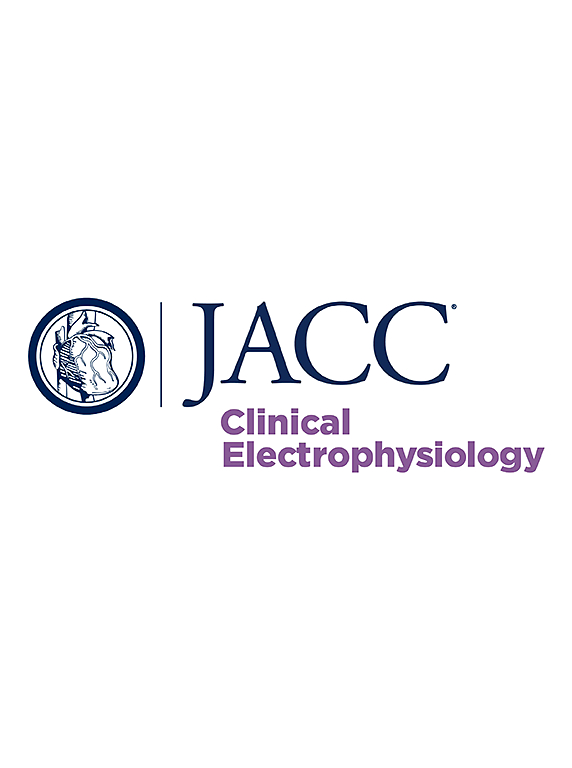儿茶酚胺能多形性室性心动过速患者无受体阻滞剂治疗策略的国际多中心队列研究。
IF 8
1区 医学
Q1 CARDIAC & CARDIOVASCULAR SYSTEMS
引用次数: 0
摘要
背景:儿茶酚胺能多形性室性心动过速(CPVT)是一种罕见的、潜在威胁生命的遗传性心脏病。非选择性β受体阻滞剂(BBs)在减少cpvt引发的心律失常事件方面非常有效。然而,一些患者遭受不可接受的BB副作用,可能需要没有BB的策略。目的:本研究旨在回顾在国际CPVT登记处登记的CPVT患者无bb治疗配置的范围和相关结果。方法:从注册表中,纳入采用无bb策略治疗≥6个月的RYR2变异阳性CPVT患者。定义了两个治疗组:极低风险患者,采用有意不治疗(INT)治疗;需要治疗但不耐受BBs的患者,采用3种不同的治疗策略。结果:总体而言,1,017例患者中有100例(10%)采用无bb治疗策略。INT组73例,其中女性33例[42%]。在66例(90%)患者中,在对无症状患者进行低风险评估和缺乏或可忽略的压力测试表型后进行INT。27例患者(22例女性,81%)采用3种不同的无bb治疗策略(氟氯胺单药治疗,n = 21;左心交感神经去支配单药治疗,n = 2;氟卡因胺+左心交感神经去支配,n = 4)。总共有25例患者(93%)之前接受过BBs治疗。在中位随访6年(四分位数间隔3-9年)期间,2例患者(2%)发生cpvt相关事件。结论:尽管非选择性BBs仍然是CPVT的基础治疗,但10%的CPVT患者需要无BBs治疗策略。经过仔细的风险评估,可以配置安全有效的无bb治疗策略。本文章由计算机程序翻译,如有差异,请以英文原文为准。
International Multicenter Cohort Study on Beta-Blocker–Free Treatment Strategies for Catecholaminergic Polymorphic Ventricular Tachycardia Patients
Background
Catecholaminergic polymorphic ventricular tachycardia (CPVT) is a rare, potentially life-threatening genetic heart disease. Nonselective beta-blockers (BBs) are highly effective in reducing CPVT-triggered arrhythmic events. However, some patients suffer from unacceptable BB side effects and might require strategies without a BB.
Objectives
This study sought to review the spectrum of and outcomes associated with BB-free treatment configurations in patients with CPVT enrolled in the International CPVT Registry.
Methods
From the Registry, patients with RYR2 variant-positive CPVT treated with a BB-free strategy for ≥6 months were included. Two treatment groups were defined: patients classified as very low risk and treated with intentional nontherapy (INT) and patients who needed to be treated but did not tolerate BBs and were treated with 3 different strategies.
Results
Overall, 100 of 1,017 patients (10%) were on a BB-free treatment strategy. There were 73 patients (33 females [42%]) in the INT group. In patients 66 (90%), INT was pursued after low-risk assessment in asymptomatic patients and absent or negligible stress test phenotype. Twenty-seven patients (22 females, 81%) were treated using 3 different BB-free treatment strategies (flecainide monotherapy, n = 21; left cardiac sympathetic denervation monotherapy, n = 2; flecainide + left cardiac sympathetic denervation, n = 4). In total, 25 patients (93%) were previously treated with BBs. During a median follow-up of 6 years (IQR: 3-9 years), 2 patients (2%) had a CPVT-associated event.
Conclusions
Although nonselective BBs remain the cornerstone treatment for CPVT, 10% of patients with CPVT required a BB-free treatment strategy. After careful risk assessment, safe and effective BB-free treatment strategies can be configured.
求助全文
通过发布文献求助,成功后即可免费获取论文全文。
去求助
来源期刊

JACC. Clinical electrophysiology
CARDIAC & CARDIOVASCULAR SYSTEMS-
CiteScore
10.30
自引率
5.70%
发文量
250
期刊介绍:
JACC: Clinical Electrophysiology is one of a family of specialist journals launched by the renowned Journal of the American College of Cardiology (JACC). It encompasses all aspects of the epidemiology, pathogenesis, diagnosis and treatment of cardiac arrhythmias. Submissions of original research and state-of-the-art reviews from cardiology, cardiovascular surgery, neurology, outcomes research, and related fields are encouraged. Experimental and preclinical work that directly relates to diagnostic or therapeutic interventions are also encouraged. In general, case reports will not be considered for publication.
 求助内容:
求助内容: 应助结果提醒方式:
应助结果提醒方式:


